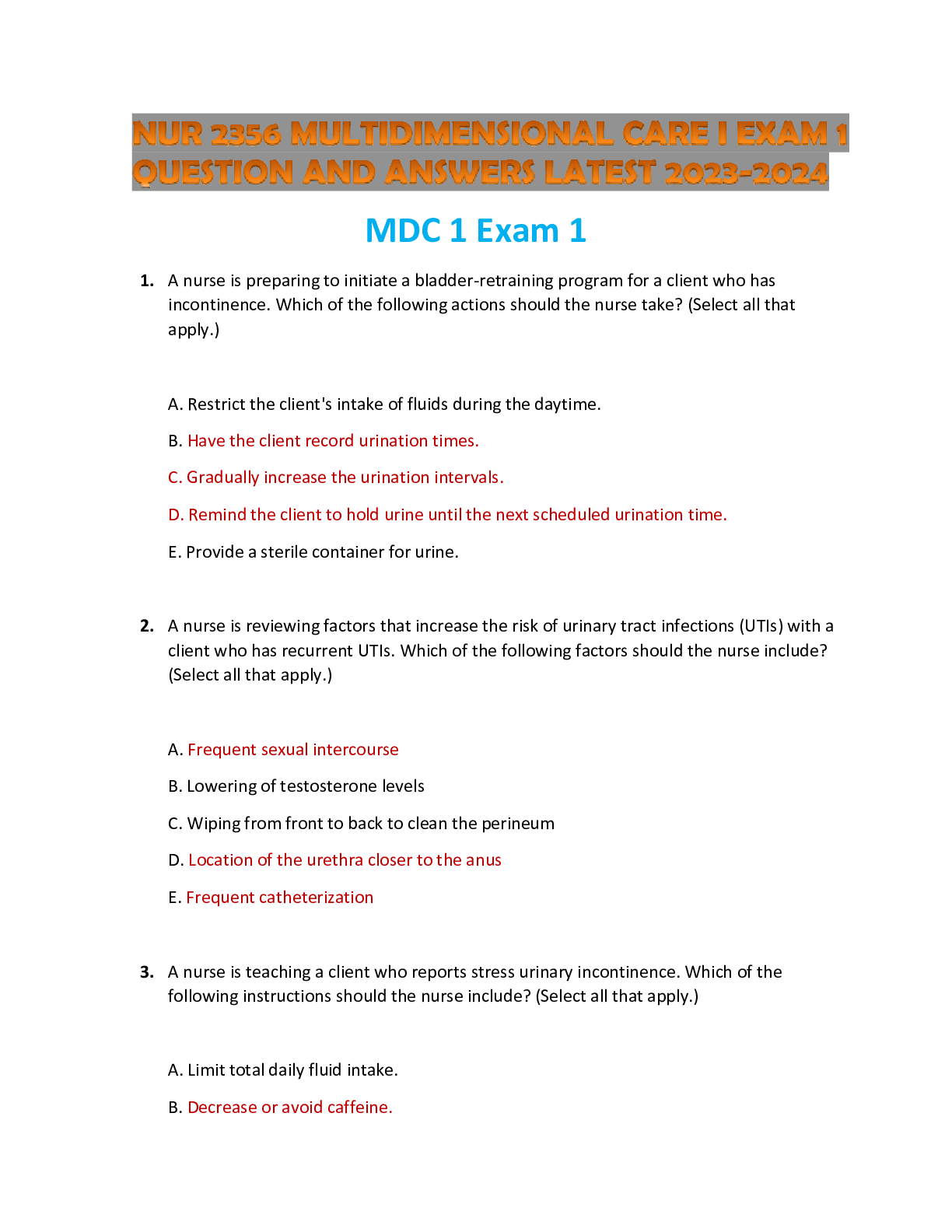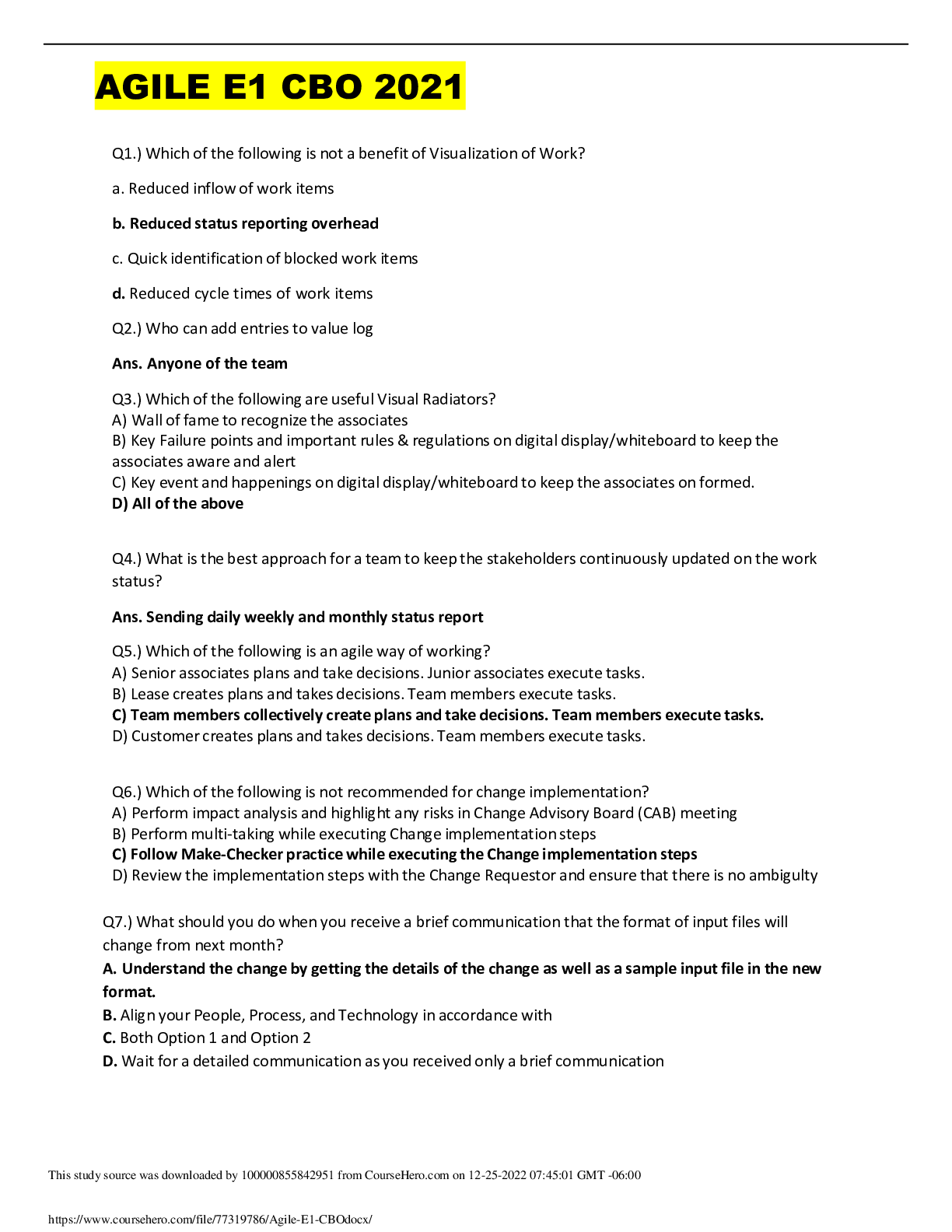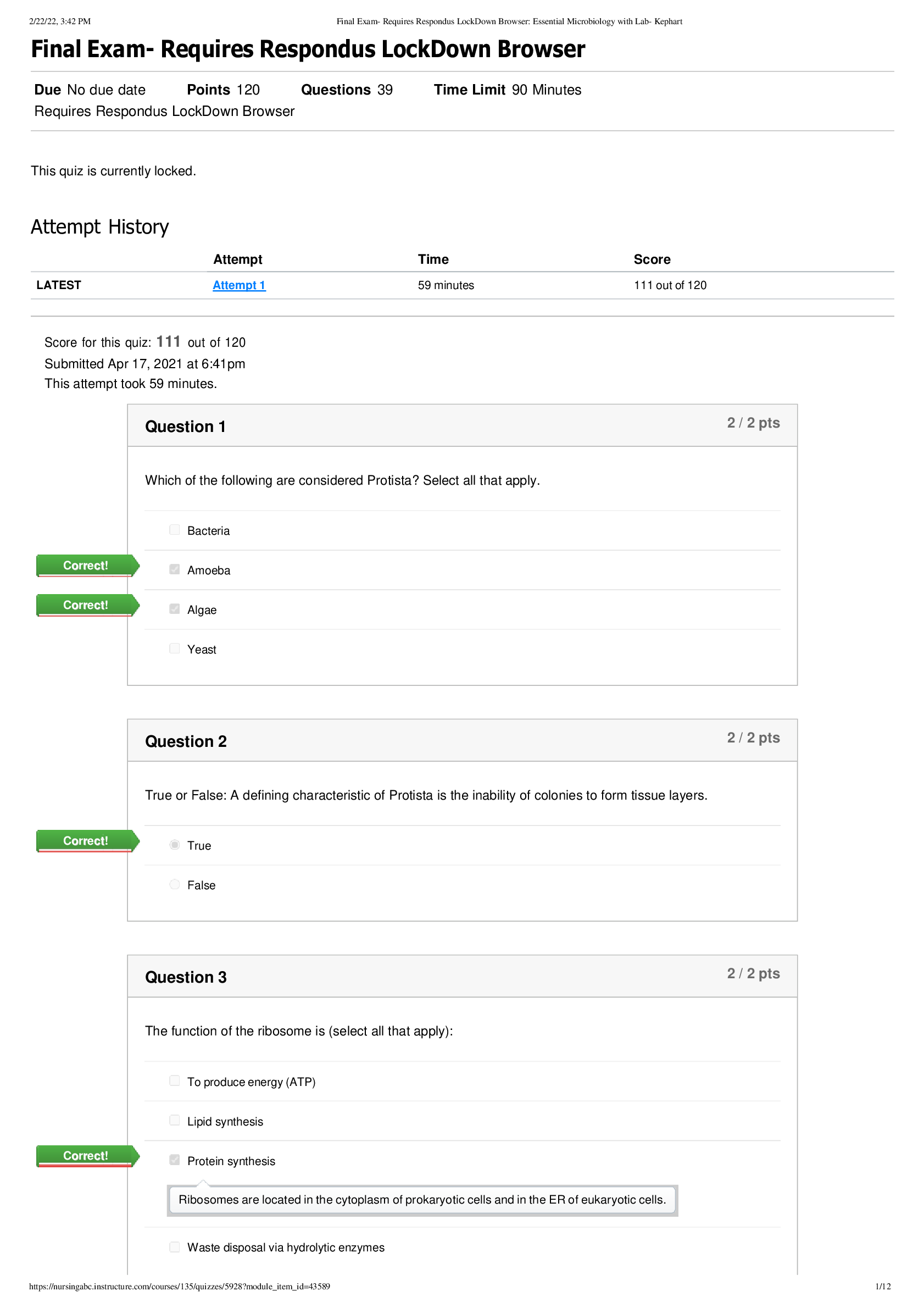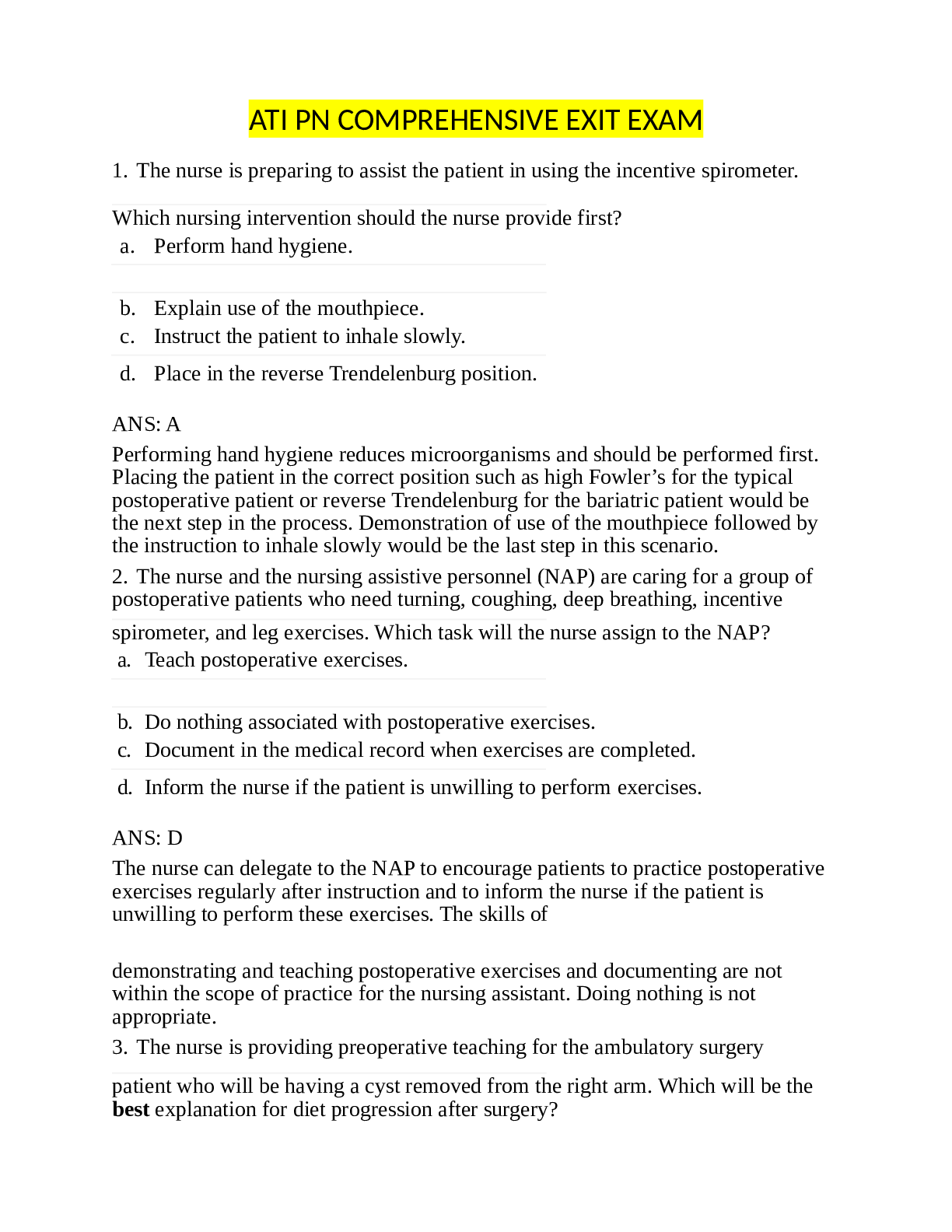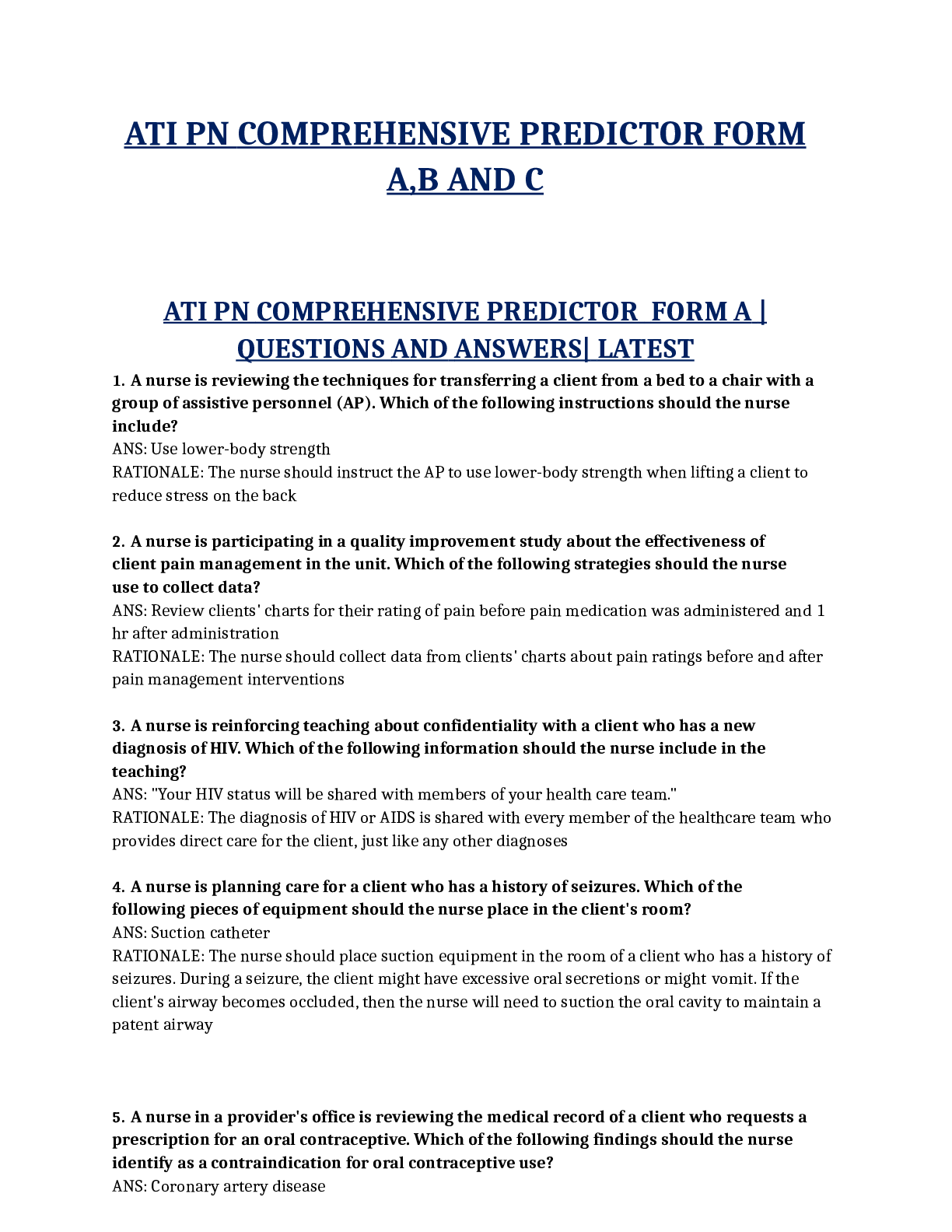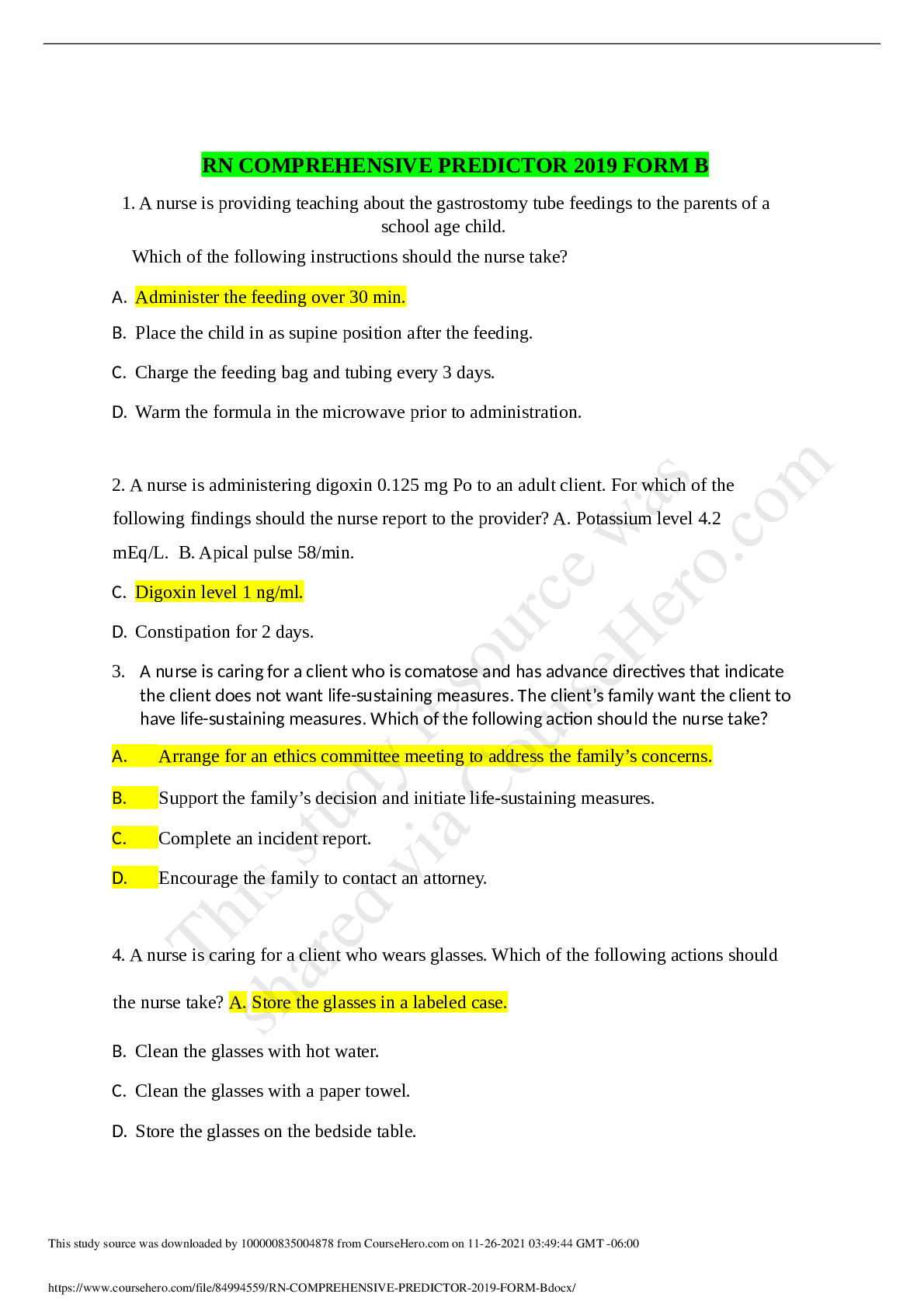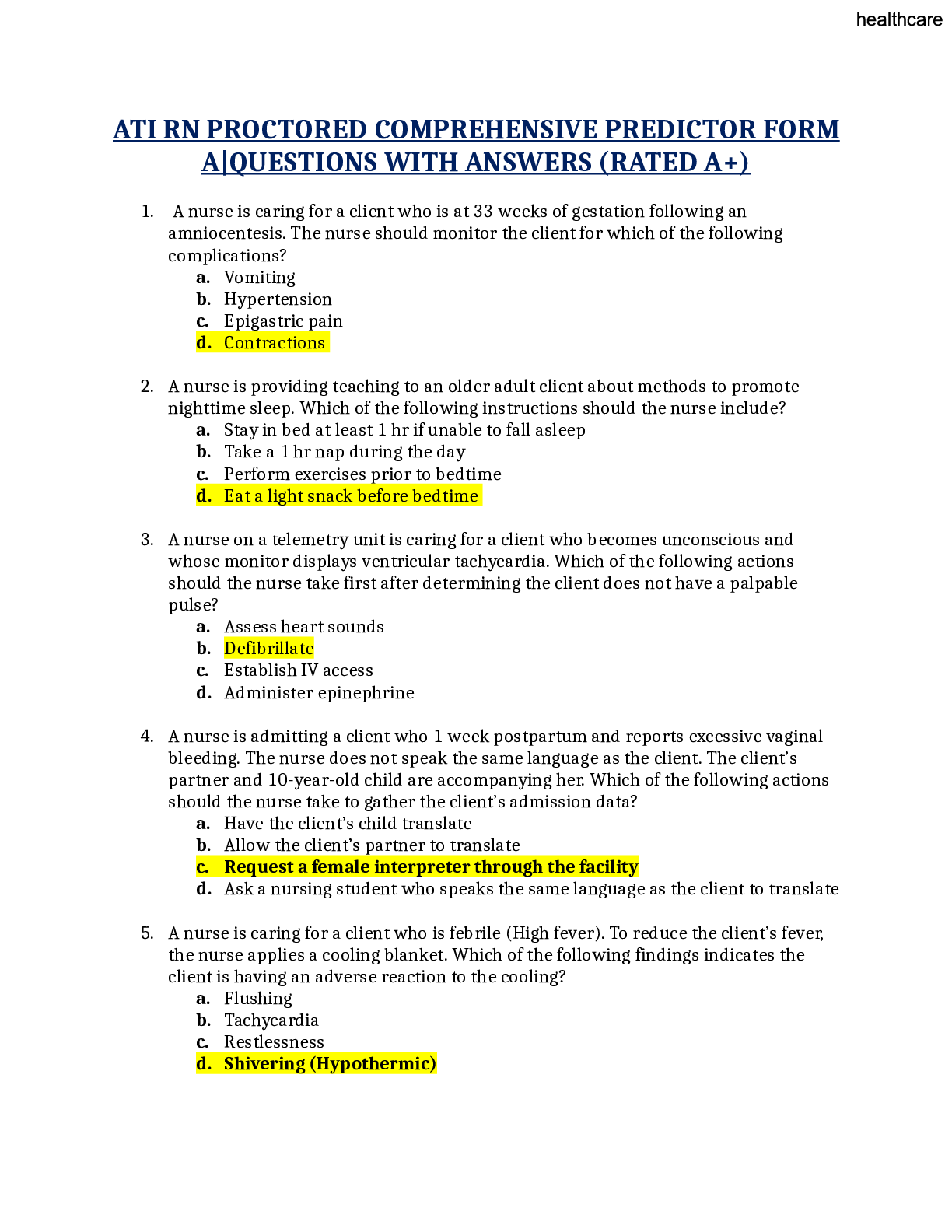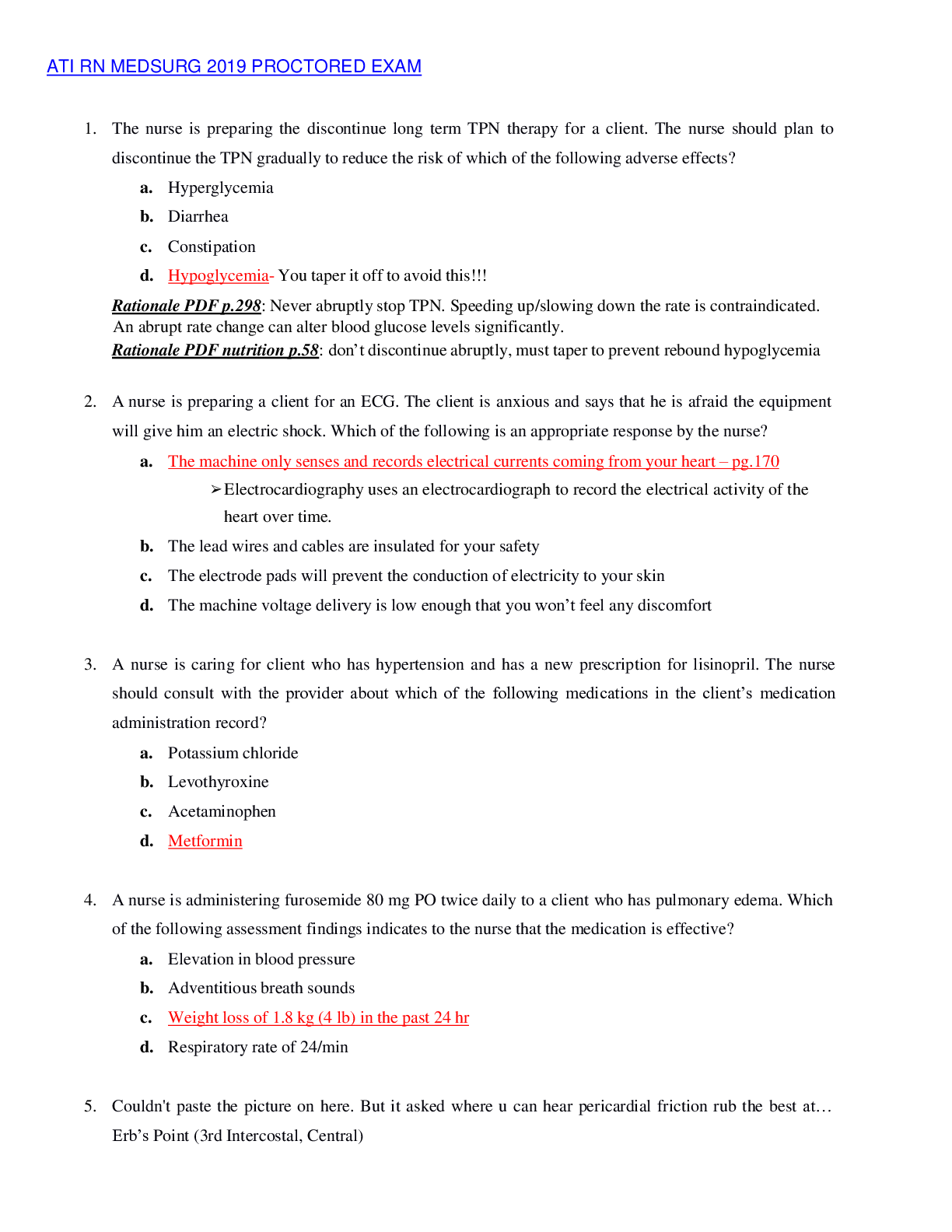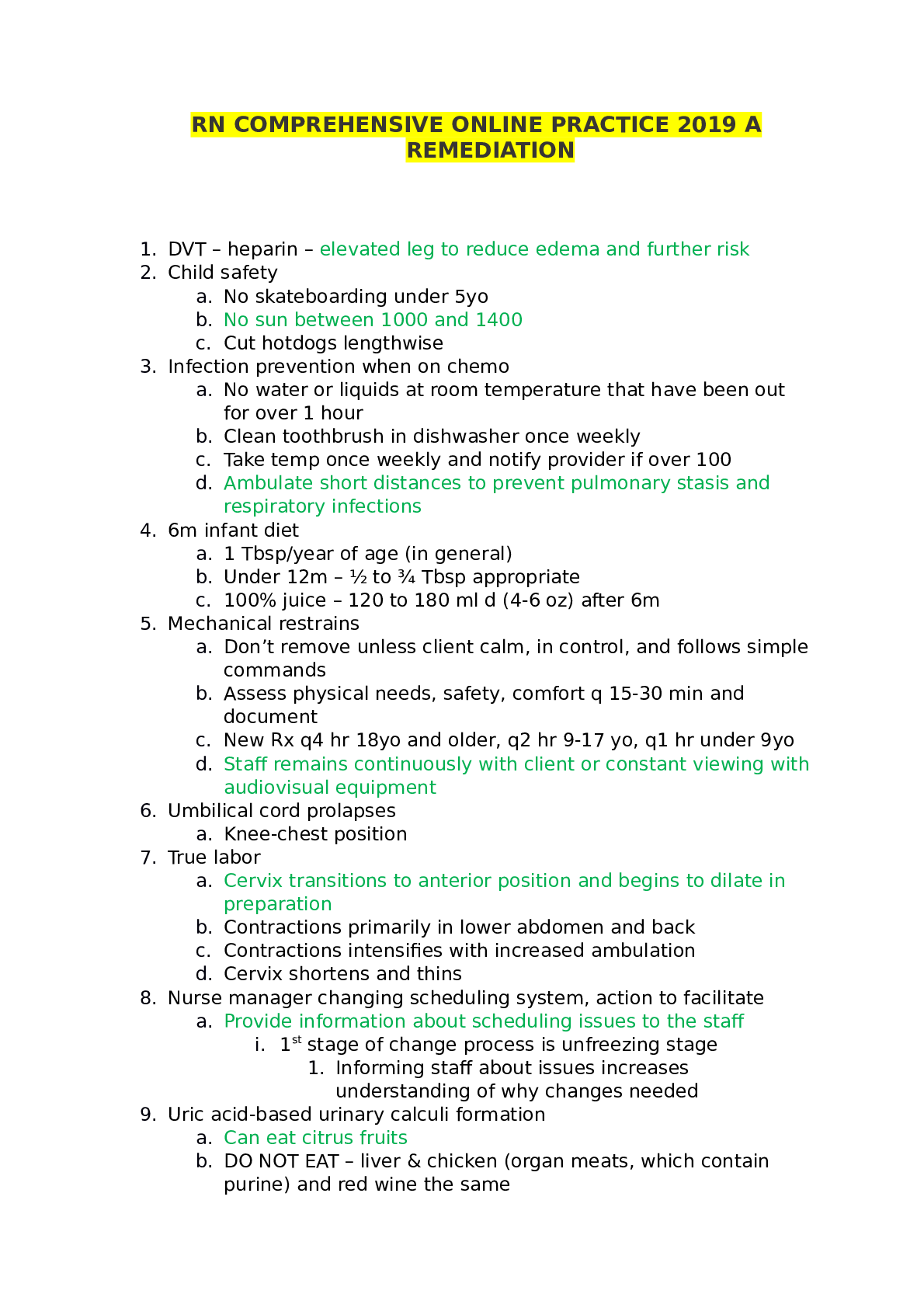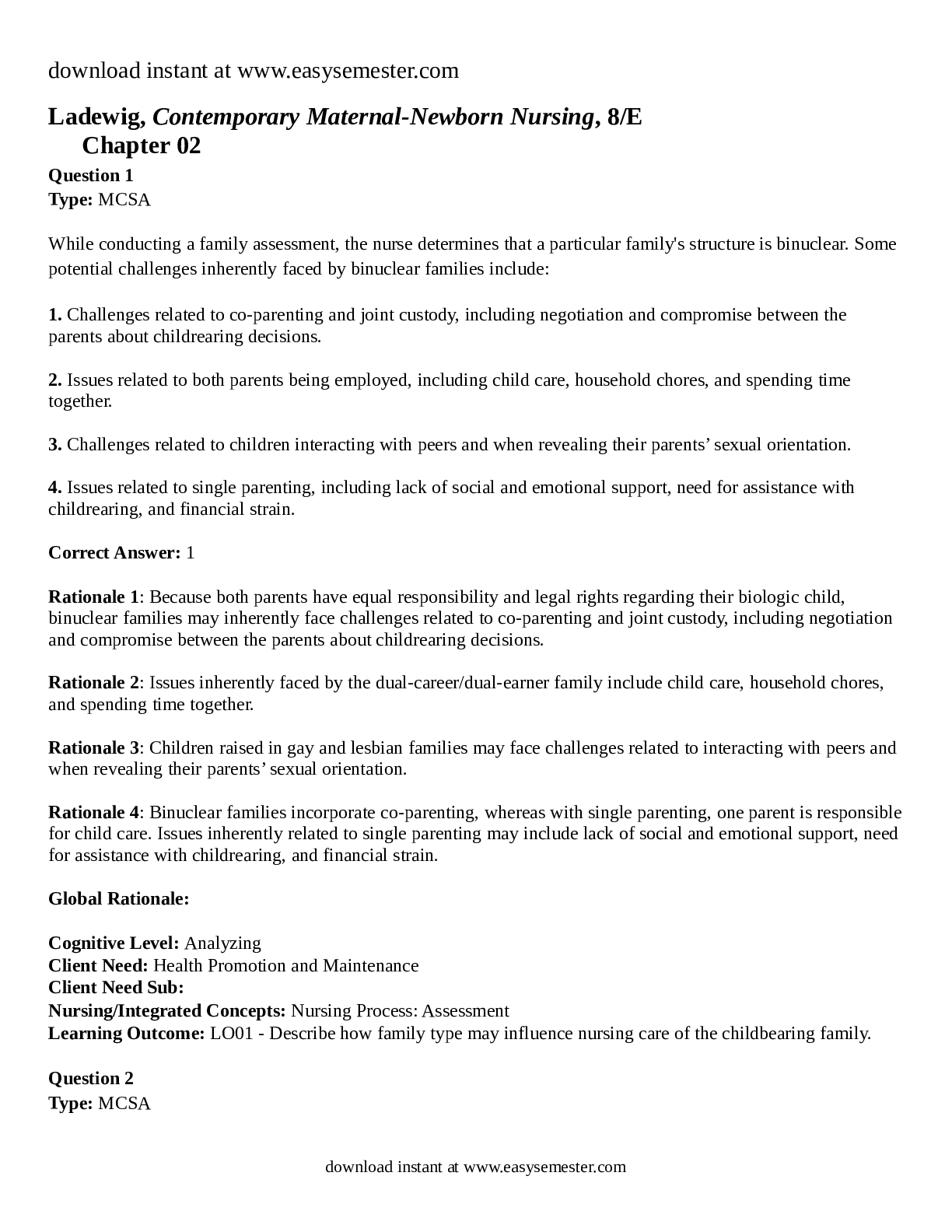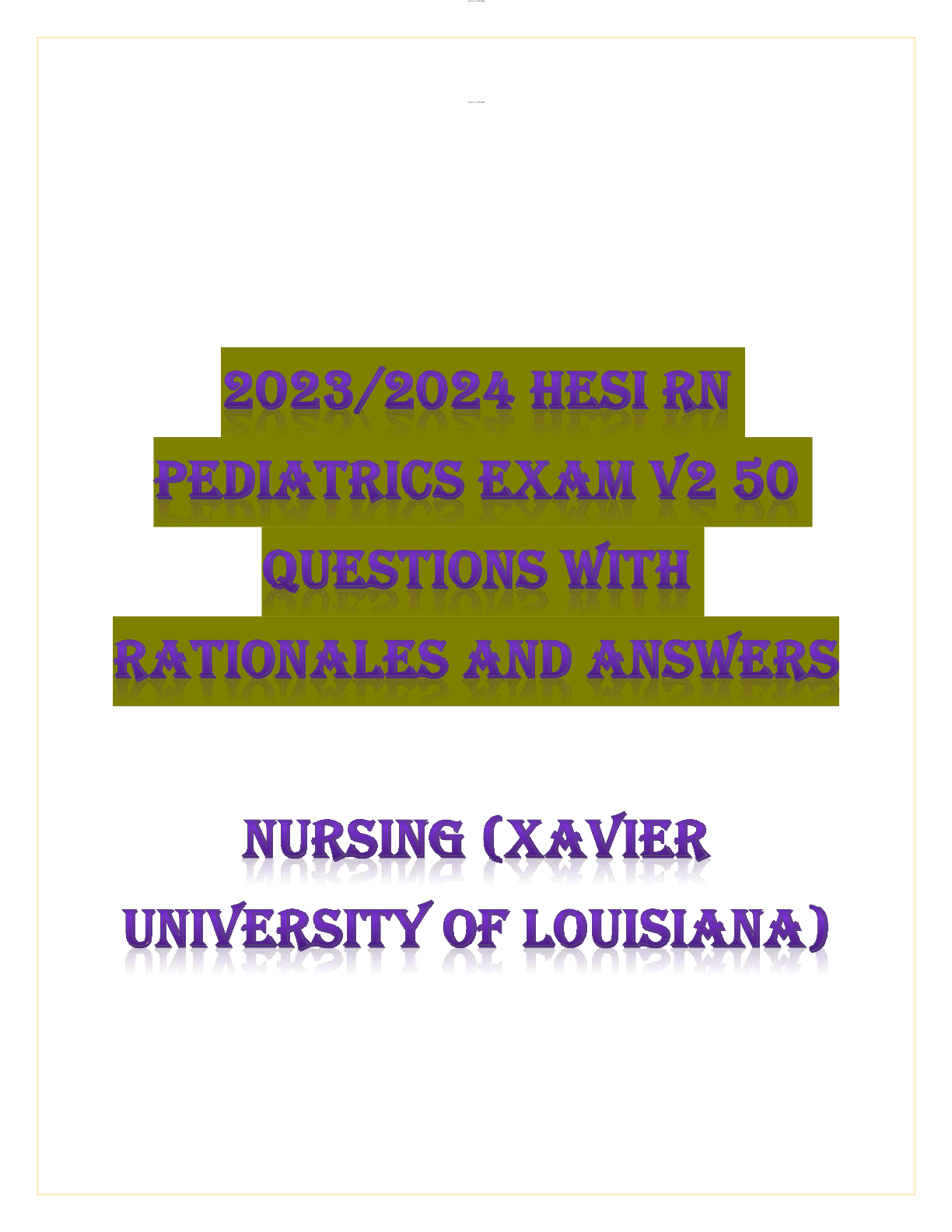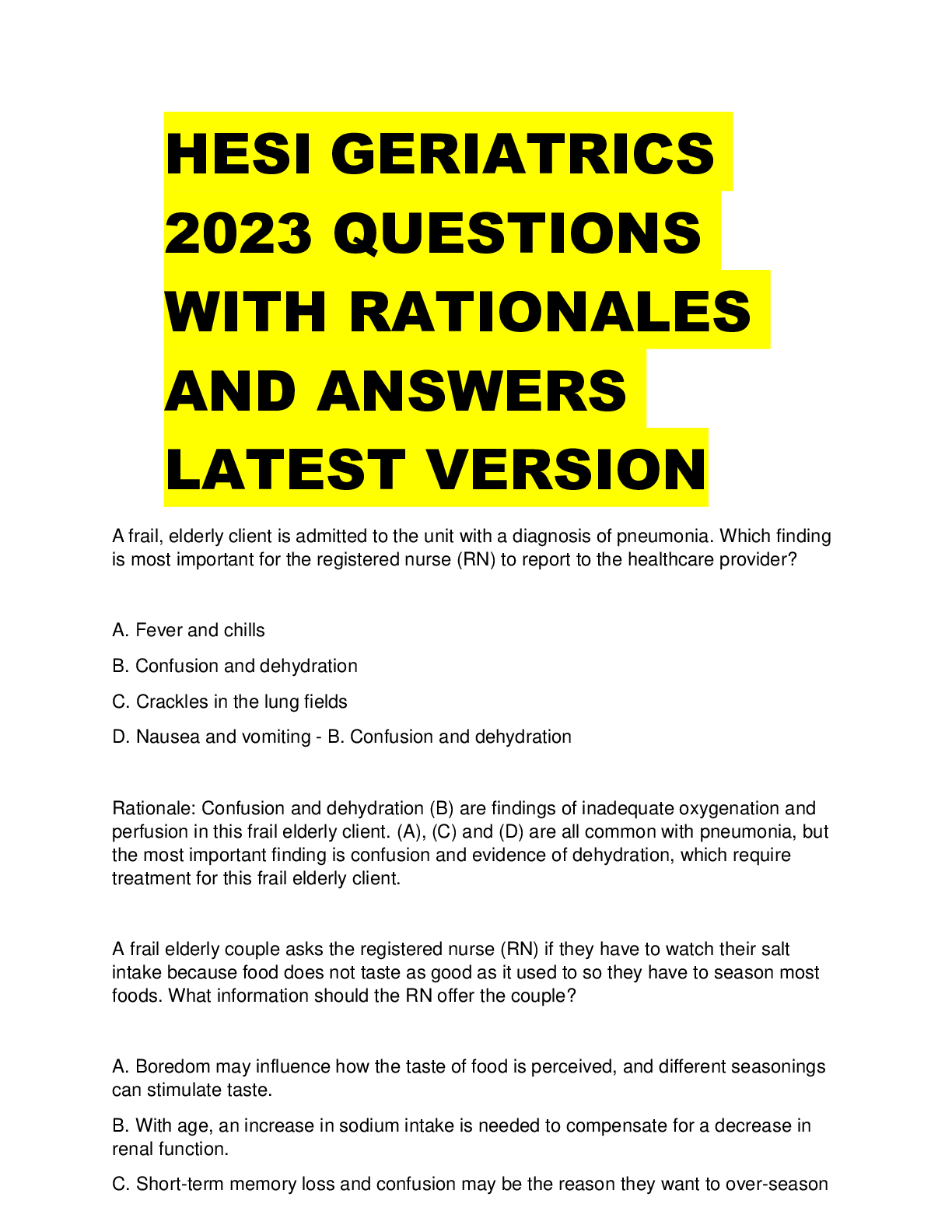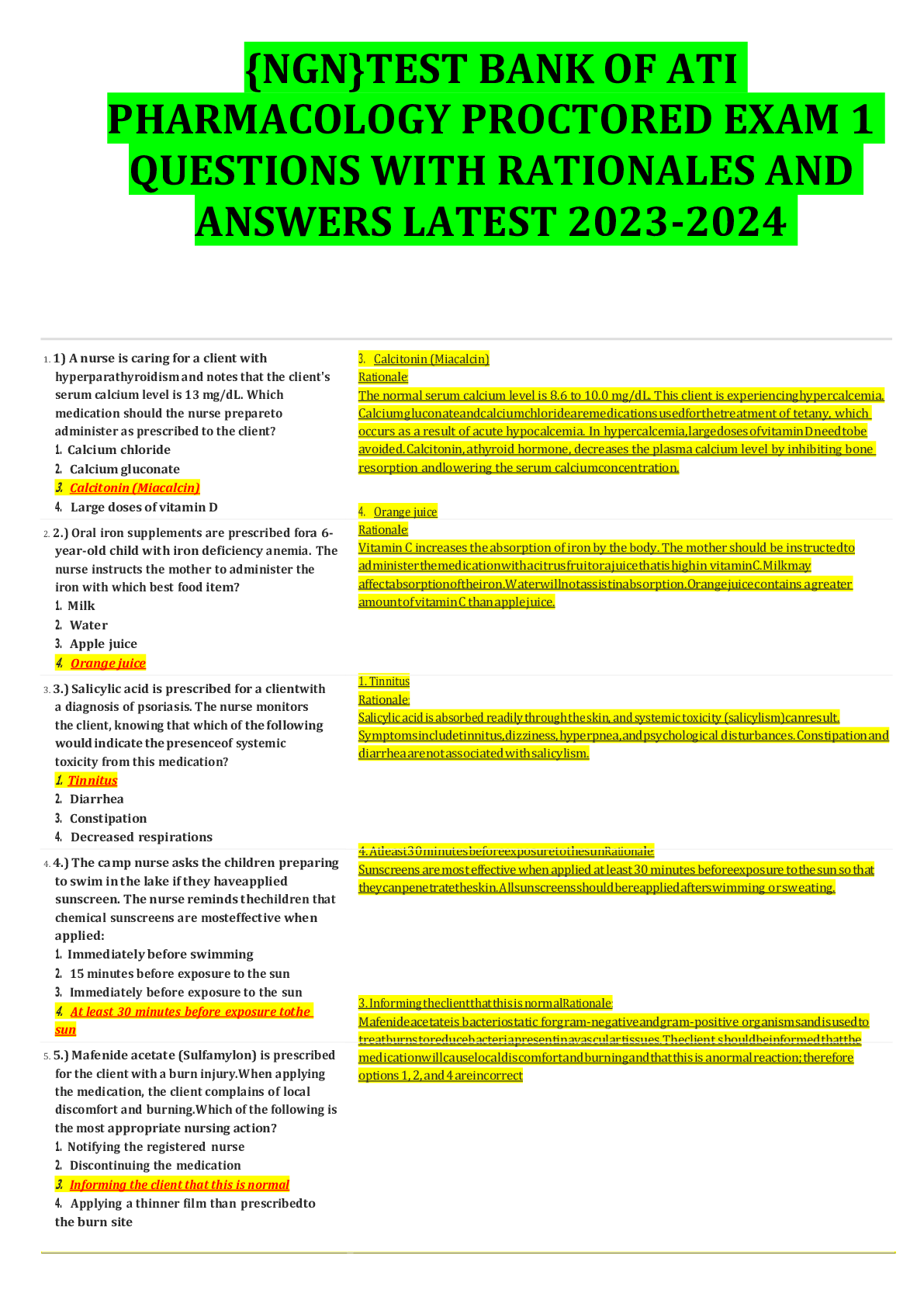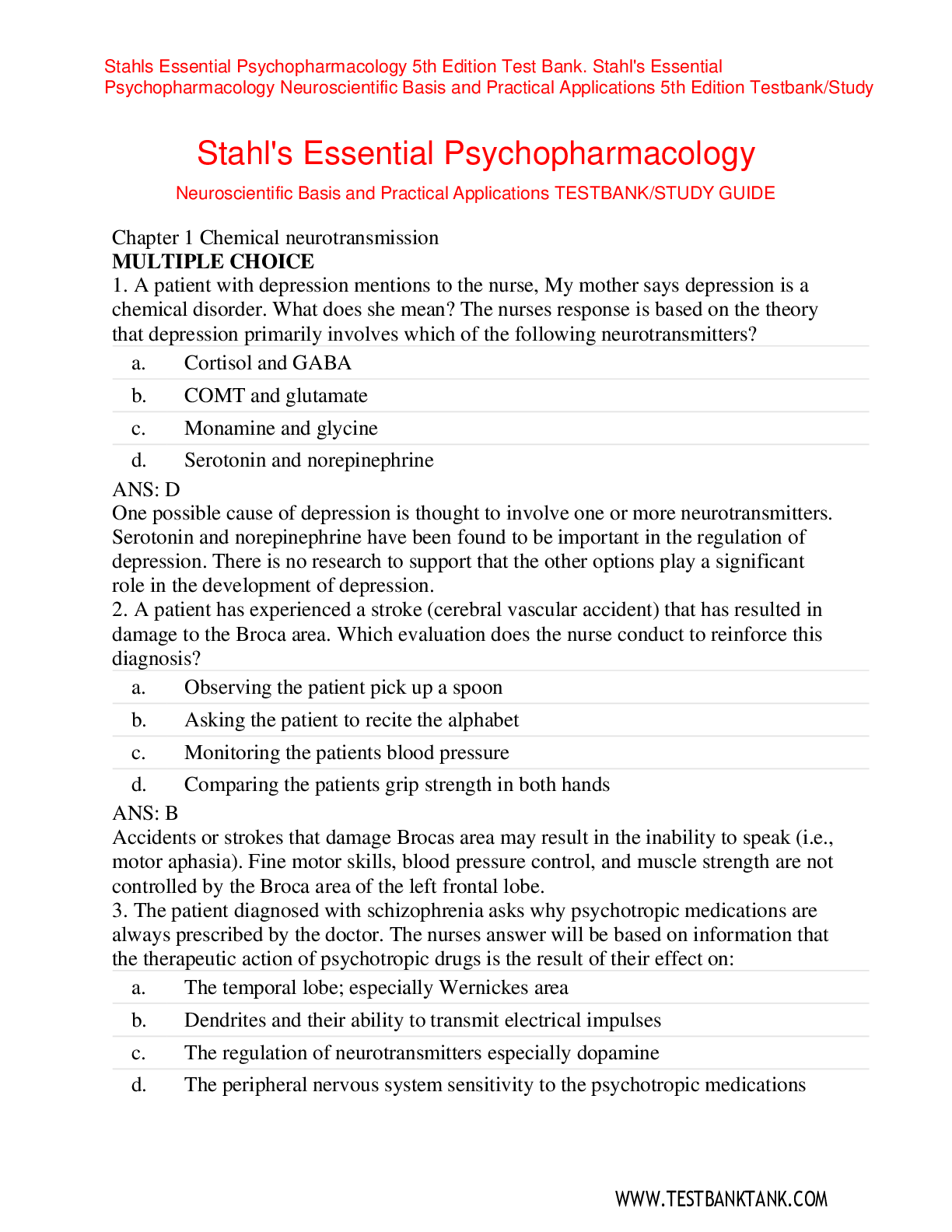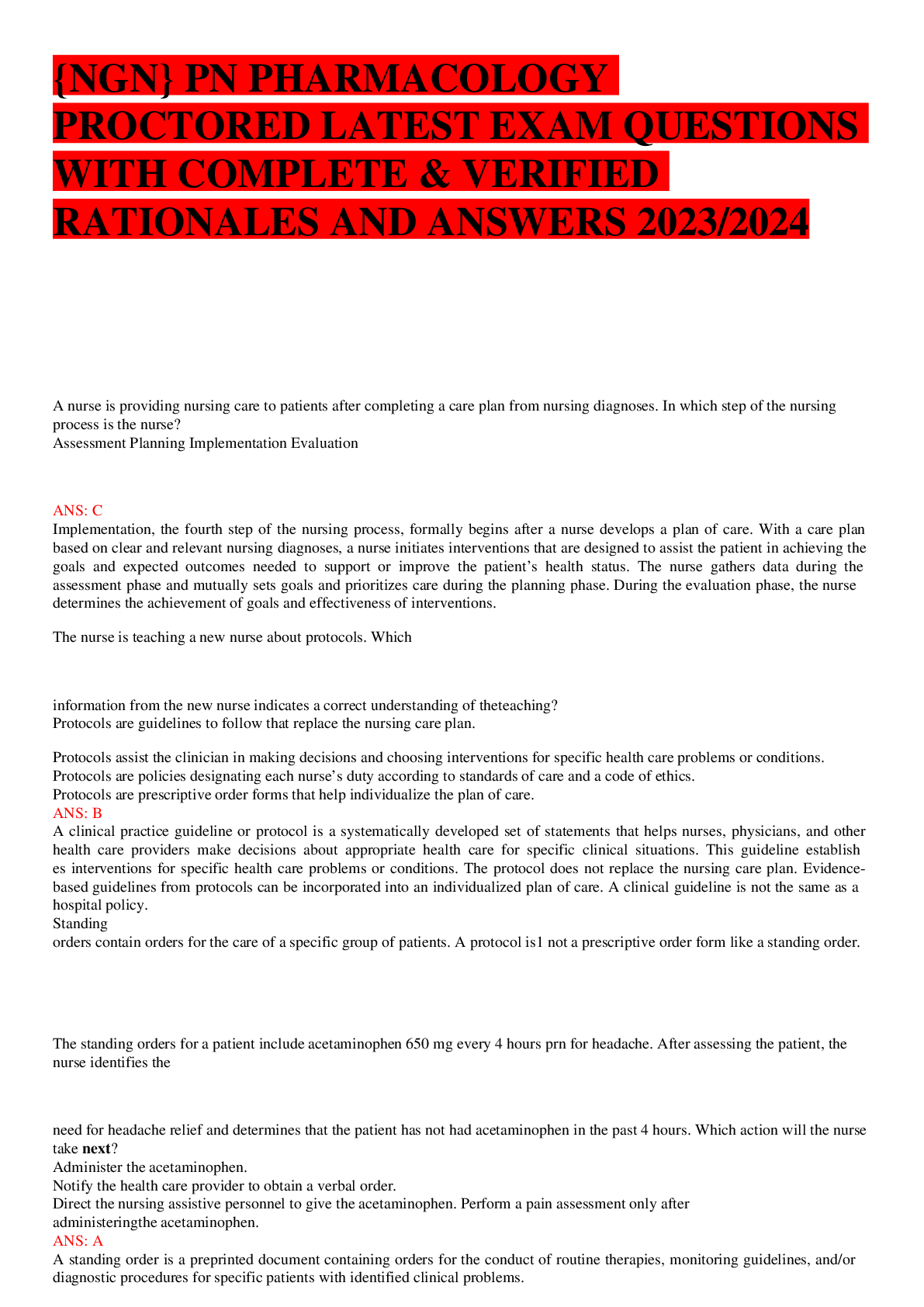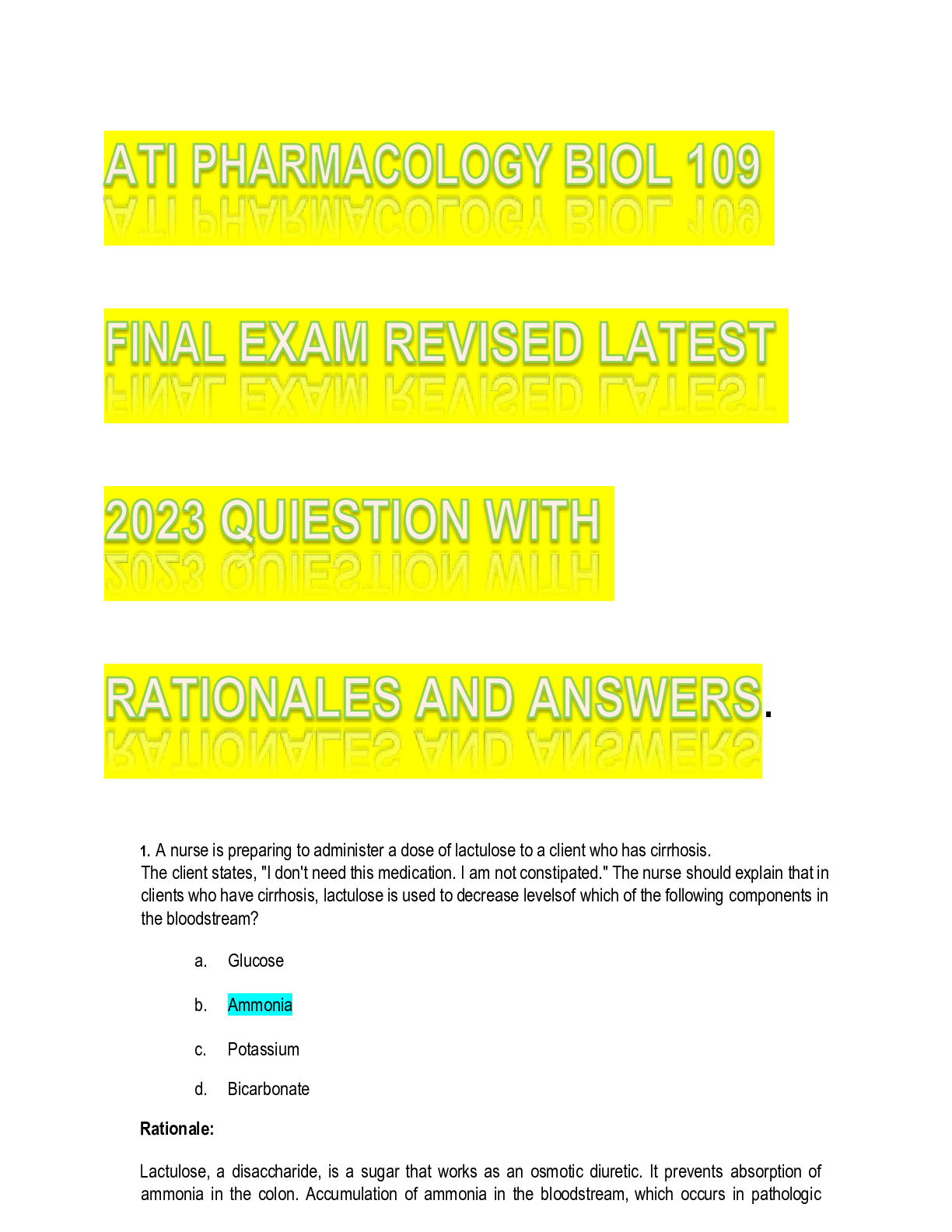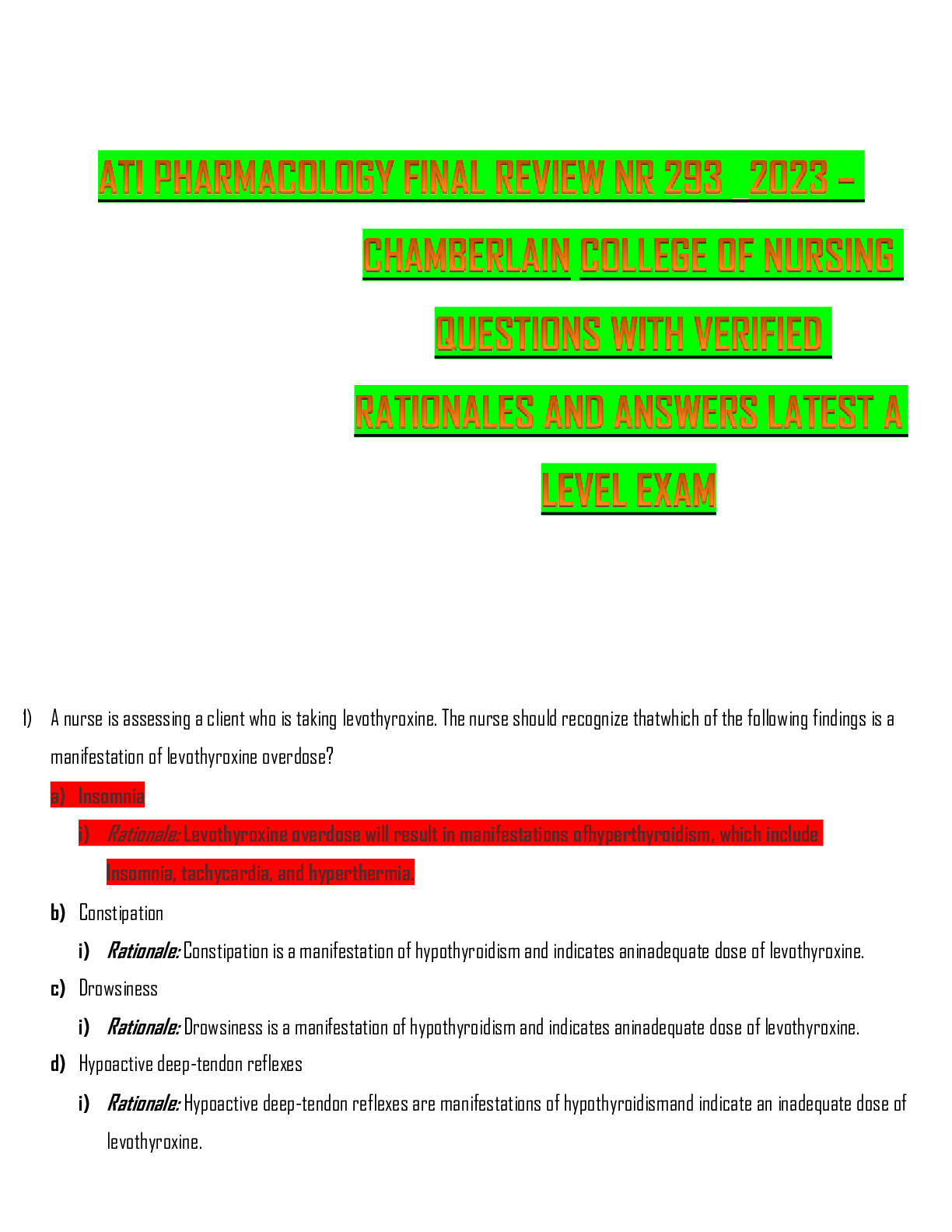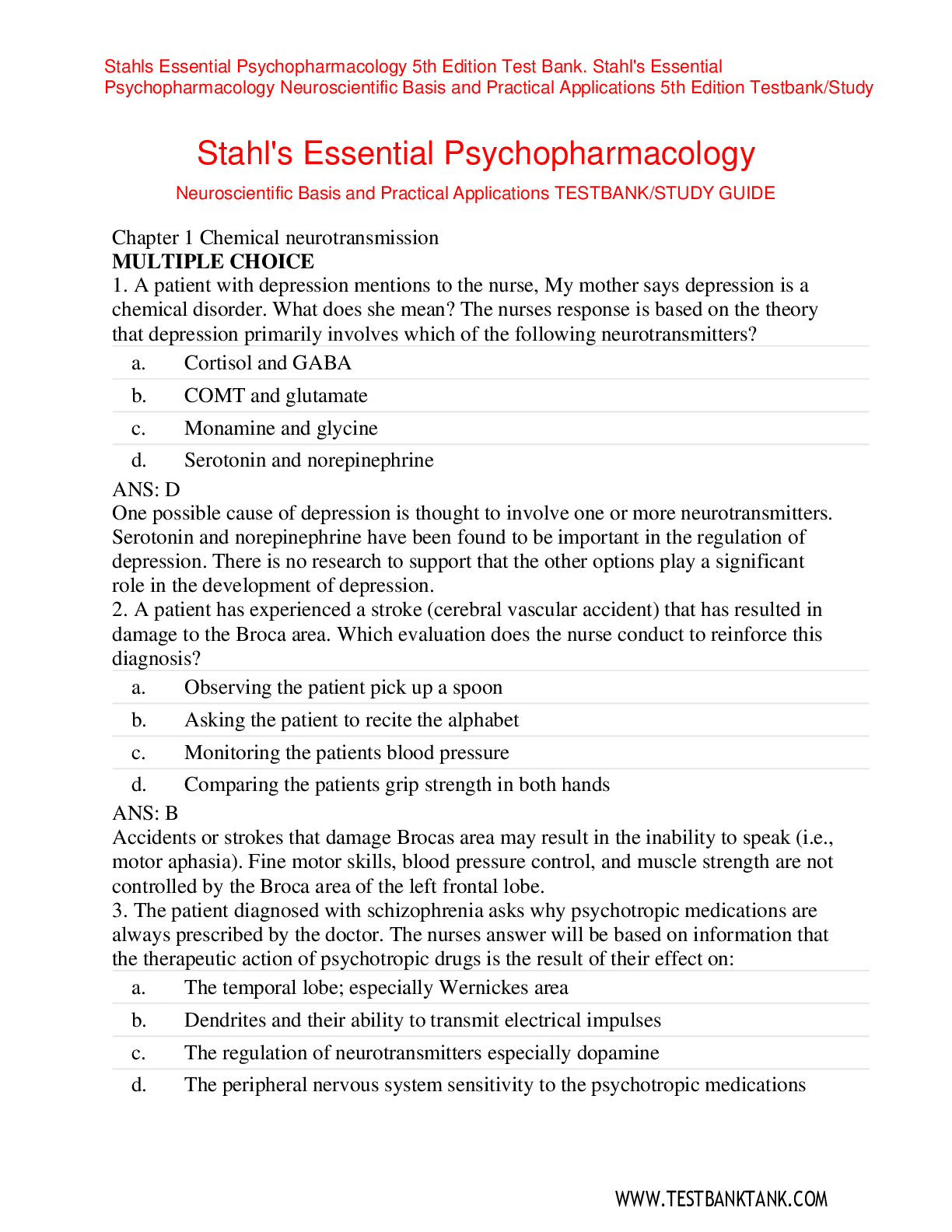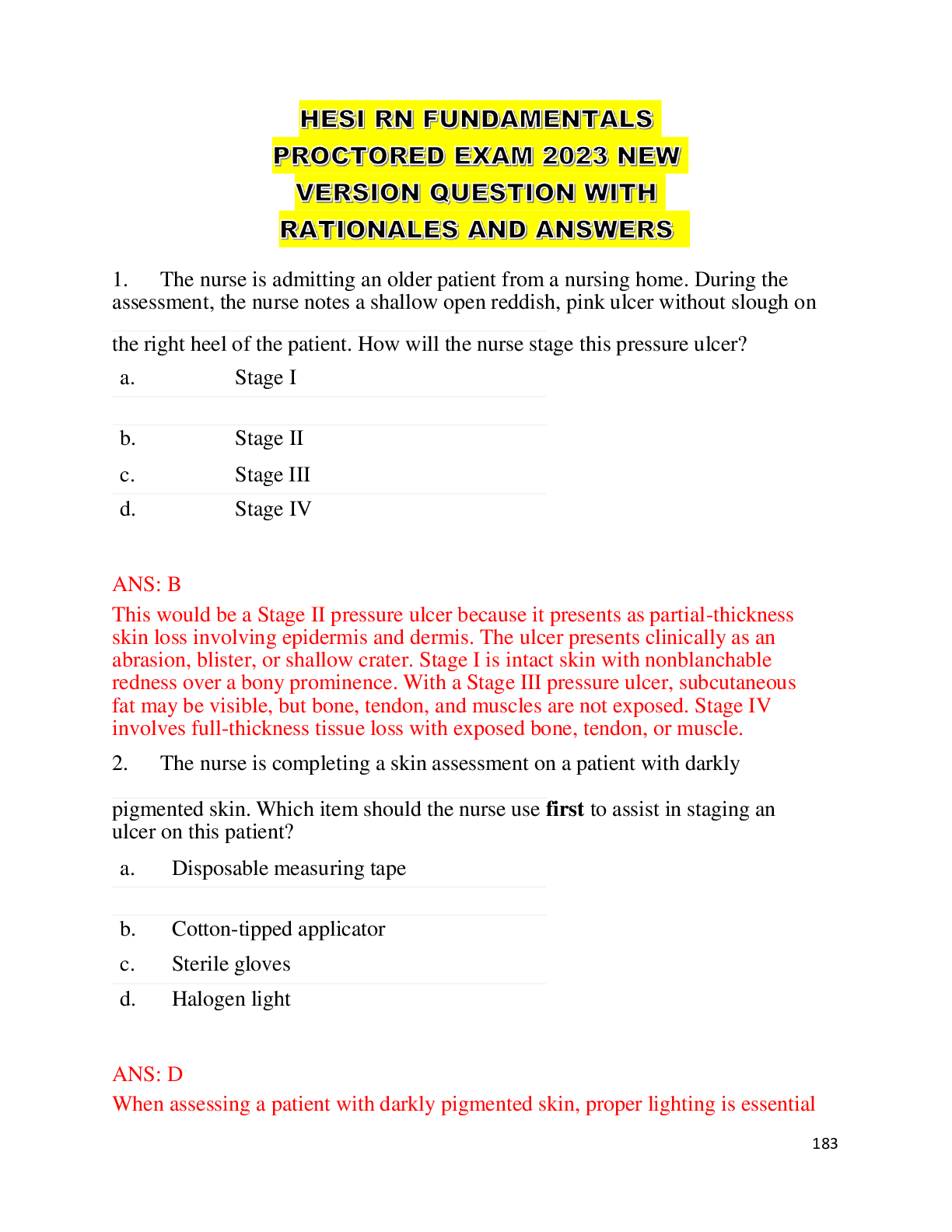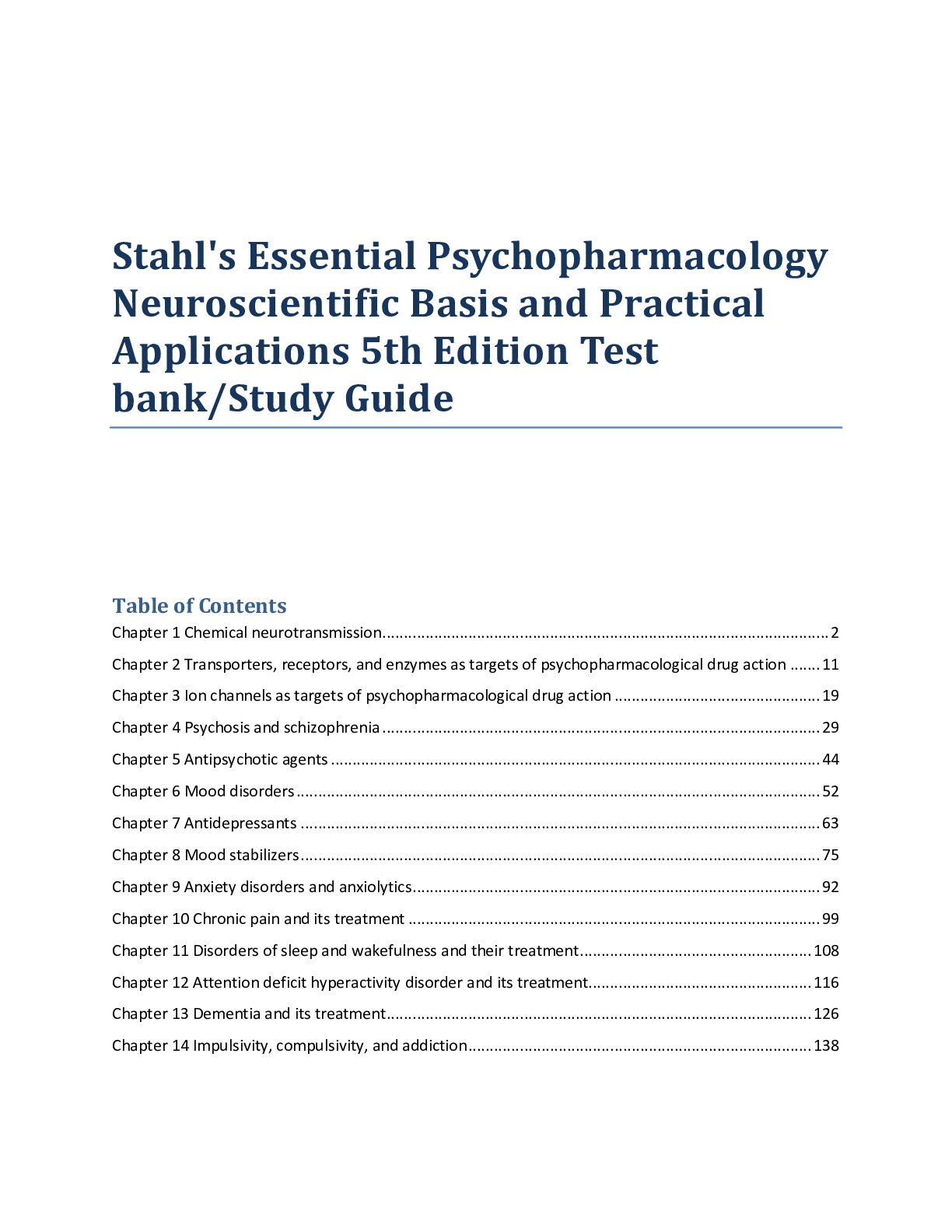Health Care > EXAM > TESTBANK STAHL'S ESSENTIAL PSYCHOPHARMACOLOGY NEUROSCIENTIFIC BASIS AND PRACTICAL APPLICATIONS QUEST (All)
TESTBANK STAHL'S ESSENTIAL PSYCHOPHARMACOLOGY NEUROSCIENTIFIC BASIS AND PRACTICAL APPLICATIONS QUESTIONS WITH RATIONALES AND ANSWERS LATEST 2023-2024
Document Content and Description Below
TESTBANK STAHL'S ESSENTIAL PSYCHOPHARMACOLOGY NEUROSCIENTIFIC BASIS AND PRACTICAL APPLICATIONS QUESTIONS WITH RATIONALES AND ANSWERS LATEST 2023-2024 Chapter 1 Chemical neurotransmission MULTIPLE ... CHOICE 1. A patient with depression mentions to the nurse, My mother says depression is a chemical disorder. What does she mean? The nurses response is based on the theory that depression primarily involves which of the following neurotransmitters? a. Cortisol and GABA b. COMT and glutamate c. Monamine and glycine d. Serotonin and norepinephrine ANS: D One possible cause of depression is thought to involve one or more neurotransmitters. Serotonin and norepinephrine have been found to be important in the regulation of depression. There is no research to support that the other options play a significant role in the development of depression. 2. A patient has experienced a stroke (cerebral vascular accident) that has resulted in damage to the Broca area. Which evaluation does the nurse conduct to reinforce this diagnosis? a. Observing the patient pick up a spoon b. Asking the patient to recite the alphabet c. Monitoring the patients blood pressure d. Comparing the patients grip strength in both hands ANS: B Accidents or strokes that damage Brocas area may result in the inability to speak (i.e., motor aphasia). Fine motor skills, blood pressure control, and muscle strength are not controlled by the Broca area of the left frontal lobe. 3. The patient diagnosed with schizophrenia asks why psychotropic medications are always prescribed by the doctor. The nurses answer will be based on information that the therapeutic action of psychotropic drugs is the result of their effect on: a. The temporal lobe; especially Wernickes area b. Dendrites and their ability to transmit electrical impulses c. The regulation of neurotransmitters especially dopamine d. The peripheral nervous system sensitivity to the psychotropic medications ANS: C Medications used to treat psychiatric disorders operate in and around the synaptic cleft and have action at the neurotransmitter level, especially in the case of schizophrenia, on dopamine. The Wernickes area, dendrite function, or the sensitivity of the peripheral nervous system are not relevant to either schizophrenia or psychotropic medications. 4. A student nurse mutters that it seems entirely unnecessary to have to struggle with understanding the anatomy and physiology of the neurologic system. The mentor would base a response on the understanding that it is: a. Necessary but generally for psychiatric nurses who focus primarily on behavioral interventions b. A complex undertaking that advance practice psychiatric nurses frequently use in their practice c. Important primarily for the nursing assessment of patients with brain traumacaused cognitive symptoms d. Necessary for planning psychiatric care for all patients especially those experiencing psychiatric disorders ANS: D Nurses must understand that many symptoms of psychiatric disorders have a neurologic basis, although the symptoms are manifested behaviorally. This understanding facilitates effective care planning. The foundation of knowledge is not used exclusively by advanced practice psychiatric nurses nor is it relevant for only behavior therapies or brain trauma since dealing with the results of normal and abnormal brain function is a responsibility of all nurses providing all types of care to the psychiatric patient. 5. A patient asks the nurse, My wife has breast cancer. Could it be caused by her chronic depression? Which response is supported by research data? a. Too much stress has been proven to cause all kinds of cancer. b. There have been no research studies done on stress and disease yet. c. Stress does cause the release of factors that suppress the immune system. d. There appears to be little connection between stress and diseases of the body ANS: C Research indicates that stress causes a release of corticotropin-releasing factors that suppress the immune system. Studies indicate that psychiatric disorders such as mood disorders are sometimes associated with decreased functioning of the immune system. Research does not support a connection between many cancers and stress. There is a significant amount of research about stress and the body. Research has shown that there are some connections between stress and physical disease. 6. A patient who has a parietal lobe injury is being evaluated for psychiatric rehabilitation needs. Of the aspects of functioning listed, which will the nurse identify as a focus of nursing intervention? a. Expression of emotion b. Detecting auditory stimuli c. Receiving visual images d. Processing associations ANS: D The parietal lobe is responsible for associating and processing sensory information that allows for functions such as following directions on a map, reading a clock, dressing self, keeping appointments, and distinguishing right from left. Emotional expression is associated with frontal lobe function. Detecting auditory stimuli is a temporal lobe function. Receiving visual images is related to occipital lobe function. 7. At admission, the nurse learns that some time ago the patient had an infarct in the right cerebral cortex. During assessment, the nurse would expect to find that the patient: a. Demonstrates major deficiencies in speech b. Is unable to effectively hold a spoon in the left hand c. Has difficulty explaining how to go about using the telephone d. Cannot use his right hand to shave himself or comb his own hair ANS: B The cerebral hemispheres are responsible for functions such as control of muscles. The right hemisphere mainly controls the motor and sensory functions on the left side of the body. Damage to the right side would result in impaired function on the left side of the body. The motor cortex controls voluntary motor activity. Brocas area controls motor speech. Cognitive functions are attributed to the association cortex. The right side of the bodys motor activity is controlled by the left cerebral cortex. 8. A patient with chronic schizophrenia had a stroke involving the hippocampus. The patient will be discharged on low doses of haloperidol. The nurse will need to individualize the patients medication teaching by: a. Including the patients caregiver in the education b. Being careful to stress the importance of taking the medication as prescribed c. Providing the education at a time when the patient is emotionally calm and relaxed d. Encouraging the patient to crush or dissolve the medication to help with swallowing [Show More]
Last updated: 2 months ago
Preview 1 out of 164 pages
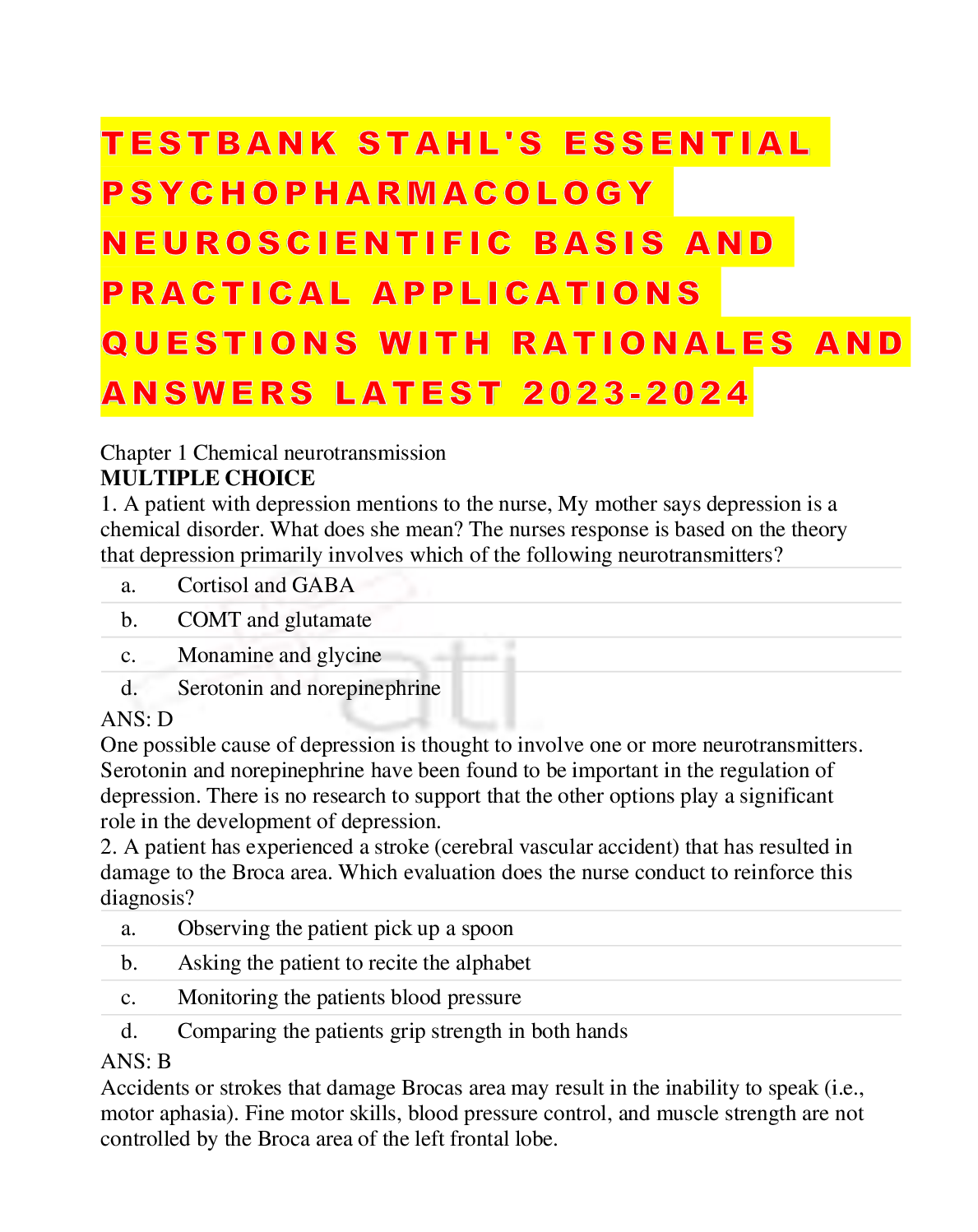
Reviews( 0 )
Document information
Connected school, study & course
About the document
Uploaded On
Feb 22, 2024
Number of pages
164
Written in
Additional information
This document has been written for:
Uploaded
Feb 22, 2024
Downloads
0
Views
14

